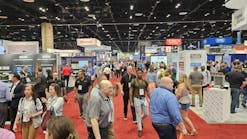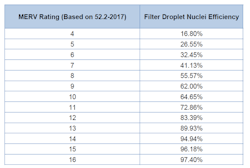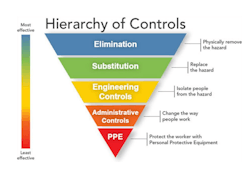By DAVID N. SCHURK, DES, CEM, LEED AP, CDSM, CWEP, SPP, CIAQM, HCCC, Global Plasma Solutions
Indoor air quality (IAQ) has long been a priority for engineers, architects, and building owners around the world, and of course, also for those who reside within their buildings. Anecdotally, good IAQ can be the difference of fewer “sick days” taken by schoolchildren, an increase office productivity, and the control of odors and chemical off gassing in medical facilities, airports and more.
Before the COVID-19 pandemic in 2020, HVAC engineers and facilities managers were in the business of keeping people comfortable. One year later, indoor air quality could be the key to our safety.
In light of the COVID-19 pandemic, improving indoor air quality has presented itself as one of the most important aspects of mitigating and potentially reducing the spread of the COVID-19 disease, caused by the SARS-CoV-2 virus.
Where We Are Headed
In light of current events, this is a perfect time to (at the very least) diligently inspect a building’s existing HVAC system to ensure “fresh” outdoor building ventilation airflows are as originally designed, and that the proper Minimum Efficiency Reporting Value (MERV) rated air-filters are clean and properly installed.
But these simple measures alone may not fill voids which limit an HVAC system from performing on the “frontline-of-defense” against the transmission and spread of airborne viruses and pathogens of concern.
In addition to the guidelines and recommendations listed by credible sources, what alternatives should be included as “best practices,” moving your facility towards improved environmental performance and better occupant outcomes?
Advanced IAQ technologies may be applied as a “bundled” approach and combined with traditional ventilation and filtration to help enhance overall efficiency and can be included in both new and existing HVAC systems.
These may lead to improved results when striving for safer, healthier, and cleaner indoor environments for the occupants residing within buildings and structures of all types, everywhere.
A few suggestions follow:
Increase Filter Efficiency
ASHRAE and others are suggesting that MERV-13 rated filters be considered as a minimum for improved standards in efficiency. High-Efficiency Particulate Arrestance (HEPA) filters may also be considered when possible and are at least 99.97% efficient in removing particles of 0.30 micrometers (μm), becoming even more efficient in removing both larger-and-smaller particles.
Aspergillus mold spores are 2.5 - 3.0 μm in diameter, with viruses ranging from 0.02 - 0.30 μm. These contaminants are of particular concern because they are found in many indoor environments, easily proliferating within HVAC systems, and can be life-threatening or deadly upon exposure to immunocompromised patients within healthcare settings.
Ultra Low Penetration Air (ULPA) filter media is also available with an efficiency rating in excess of 99.999% at 0.12 μm. Both HEPA and ULPA filters should be applied carefully, with consideration of the additional airside pressure drop they may add to the HVAC air-handling system.
Ultraviolet Germicidal Irradiation (UVGI)
Ultraviolet Germicidal Irradiation (UVGI) is a recognized technology which has proven to help provide surface disinfection which limits the growth of bacteria and mold-containing bio films on damp or wet componentry within air-handling units (AHUs). UVGI lamp systems are typically located immediately downstream of cooling coil and drain pan areas, where UVGI energy is continuously directed on these surfaces to help disable various organisms so that they are unable to replicate and potentially cause harm.
ASHRAE has made the following statement about UVC lights in their Position Document on Filtration and Air Cleaning:
The effectiveness of a UV-C system to inactivate microorganisms in the air and/or on surfaces has been amply demonstrated; the best results were obtained for the long-term irradiation of downstream coil surfaces to avoid fungal amplification on wet surfaces. Experience suggests that control of a moving airstream does not provide favorable killing rates because of the short dwell time.
Upper Air UVGI Devices
Upper Air UVGI Devices are similar to those described above, but the fixture is located within the occupied environment, designed and installed to irradiate only air in the upper region of the space. Efficacy of this technology relies on fixture placement and the adequacy of air currents in bringing contaminated air into the upper UV zone. In buildings with continuous occupancy and/or with immunocompromised populations, such as healthcare environments, upper air UVC systems may help control transmission of airborne pathogens at their source.
Studies have shown that in combination with appropriate room ventilation measures, it can be effective at helping to reduce the spread of certain airborne infectious diseases.
Needlepoint Bipolar Air Ionization (NPBI)
Needlepoint Bipolar Air Ionization (NPBI) may not only help eliminate mold growth in HVAC air-handling systems but can also help address a variety of IAQ issues including contaminants brought in from outdoors (allergens, motor vehicle exhaust, gasoline vapors, chemicals, helipad and emergency generator exhaust), as well as certain viruses and VOCs occurring within the space.
While not filters themselves, advanced IAQ technologies such as NPBI can help enhance the efficacy of traditional ventilation and filtration systems. Very small airborne viral material and other contaminants are certainly very small particles which are both difficult to move and filter, while being of considerable concern. This technology is capable of agglomerating (combining) small particles in the space itself, making them larger and therefore easier to move in the air and remove via air filtration. Lesser efficient filters can be more effective in removing larger particles in the air.
In addition to NPBI helping rid indoor environments of particulate, this technology can provide additional IAQ benefits by breaking down various volatile organic compounds (VOC’s), which may consist of chemical mixtures (indoor cleaning agents) and numerous types of objectionable odors. Applied upstream of wet cooling coils, it can help eliminate issues with biofilm and microbial growth in HVAC air-handling systems.
NPBI has been tested both in the field and under laboratory conditions for its effectiveness at helping remediate certain issues of concern in the space, including specific viruses and pathogens such as SARS-CoV-2. A misnomer is that this process kills viruses; rather, it deactivates them, so they are no longer infectious. This technology can help reduce the volume of infectious airborne pathogens to make air cleaner and safer to breathe.
Humidification and keeping the relative humidity in the buildings breathing zone between the ranges of 40%-60% RH, can have an effect on our health, as well as limiting the spread of airborne viruses. If the air is too dry, infectious droplets expelled by sick individuals can quickly evaporate and shrink.
These tiny, desiccated particles can be suspended in the air, where they may travel by air currents in the space to spread infection among occupants. Research from NIH [National Institute of Health], Princeton, and Harvard show that the infectivity of viruses in the air and on surfaces can be reduced when the proper relative humidity is maintained in this range. Data also shows that when people within the built environment are exposed to indoor relative humidity at 40%-60%, their “human-mechanisms” for physiological defense are improved.
COVID-19 Recommendations
ASHRAE has recognized that the transmission of SARS-CoV-2 through the air is sufficiently likely and that airborne exposure to the virus should be controlled. Changes to building operations, including the operation of heating, ventilating, and air-conditioning systems, can reduce airborne exposures.
ASHRAE's statement on operation ofHVAC systems to reduce SARS-CoV-2/COVID-19 transmission:
Ventilation and filtration provided by heating, ventilating, and air-conditioning systems can reduce the airborne concentration of SARS-CoV-2 and thus the risk of transmission through the air. Unconditioned spaces can cause thermal stress to people that may be directly life threatening and that may also lower resistance to infection. In general, disabling of heating, ventilating, and air-conditioning systems is not a recommended measure to reduce the transmission of the virus.
1. Source Control: Eliminate or control the sources of pollution;
2. Ventilation: Dilute and exhaust pollutants through outdoor air ventilation;
3. Air Cleaning: Remove pollutants through proven air cleaning methods.
Closing Thoughts
Facility design can be a blend of code and standards compliance along with a healthy dose of engineering best practice. Whether it be in the healthcare, education, hospitality, manufacturing or commercial office sectors, professionals involved in the design of these complex facilities must keep abreast of ever-changing needs and requirements while taking keen interest in the rapid evolvement of each industry.
Regardless of when, or if, “herd immunity” is ever achieved among the world’s population via mass vaccination efforts, these industries will never return to status quo. Engineers responsible for the systems which produce the temperature, humidity, air movement, ventilation and filtration within these environments are under increased pressure. They must assure facility owners and operators that their designs meet stringent code mandates while also contributing to the complex dynamics of occupant well-being and improved outcome.
##########
An ASHRAE distinguished lecturer and licensed designer of engineering systems, the author is director of business development for Global Plasma Solutions, based in Charlotte NC. He has nearly 40 years of experience in the design and analysis of HVAC systems for a variety of market sectors, with a special focus on hospital and healthcare environmental control and indoor air quality.













